1946: Susie the “King” Cat of Brooklyn’s Bay Ridge Wharf
Posted: September 15, 2013 in Featured Felines, King Cat of the Bay Ridge WharfTags: Atlantic Yacht Club, Bay Ridge, Brooklyn Beach, Cat Stories, Kerr Steamship, New York History, Sunset Park, Sunset Play Center
0
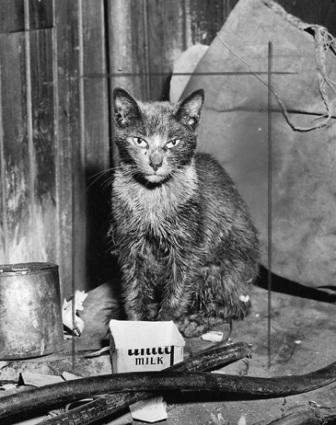
Gaunt,
soggy, and covered in grease, Susie barely had enough energy to eat
following her five-day ordeal under a pier at the foot of 57th Street in
Bay Ridge (now part of Sunset Park), Brooklyn. Photo: Brooklyn Public
Library
It was rat hunting that got Susie into deep trouble on July 14, 1946. According to news articles from Brooklyn, Pittsburgh, and even Toledo, Susie was chasing a rat that tried to escape the menacing feline by diving from the pier into the New York Bay. Susie dove in right after the drowning rat, determined to make the kill. When she surfaced, she came up under the pier and had to scramble onto a crossbeam just above the high tide water level to await rescue. The fate of the rat is unknown, although my bet is on Susie.
For five days, workmen on the piers tried to rescue Susie, but to no avail. In desperation, the men called the New York Harbor Police, who thought it best to wait for low tide before attempting a rescue. Two workmen–Vincent Caramico, a dock handyman, and Peter Arnao, a tractor boss—sensed that Susie was getting hungry, so they decided to take matters into their own hands. Using a crane and three 20-foot planks, they were able to reach up under the pier and rescue the cat.

Many
kind men were involved in Susie’s rescue, including the New York Harbor
Police, who responded to the scene. Photo ca. 1940s.
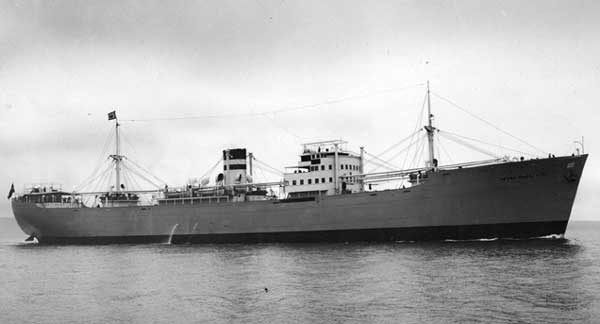
The M/S Høegh was
a general cargo motor ship that sailed out of Bombay, Calcutta, and
other South Asian ports in the 1930s and post WWII. Photo: Historical
Department, MAN B&W Diesel, Copenhagen
According to the workmen, Susie arrived at the Kerr Steamship pier in November 1945 on a ship that had originated in India. Based on my research, including voyage records from the Norwegian National Archives, it is most likely that Susie arrived in Brooklyn on November 12, 1945, on the M/S Høegh Silverstar. Kerr Steamships Limited was the general agent for the Silver-Høegh Line, which operated freight services and accepted cargo for ports in Egypt, India, Pakistan, and the Persian Gulf. The Høegh Silverstar departed from Bombay, India, on October 15: I have a very strong feeling that Susie the king rat killer was onboard doing rat duty for Captain Alf Slaatten as the ship made its way to Brooklyn.
1936: The Year of the New York City Swimming Pool
Exactly ten years before Susie took her unexpected swim in the New York Bay, more than 3,000 children and adults attended the opening events for the Sunset Play Center and outdoor swimming pool at Sunset Park. The Sunset Play Center featured an Olympic-size swimming pool that had diving and wading pools and a one-story brick bath house, and could accommodate 4,850 swimmers. Following on the heels of an oppressive heat wave, the grand-opening of the public pool was a refreshing event for Brooklyn’s residents.
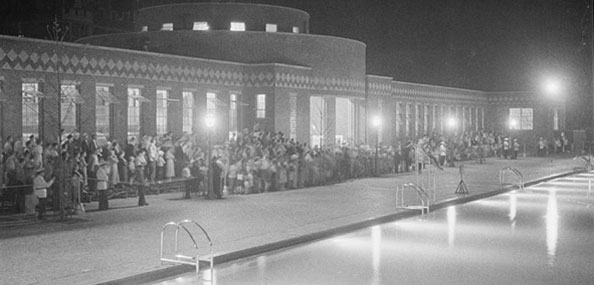
An
estimated 3,500 people attended the opening of the Sunset Play Center
on July 20, 1936. After Mayor LaGuardia turned on the pool’s lights,
shown here, Julia Peters of the Metropolitan Opera Company concluded the
ceremony by singing the Star Spangled Banner.
I came across the following account in The New York Times archives, which was written by Robert Moses, an avid swimmer, after becoming Parks Commissioner in 1934. I think his words neatly summarize the tragic history of Brooklyn’s waterfront neighborhoods, which, like those of Sunset Park and Bay Ridge, were transformed from sandy beaches, rural farms, and majestic resorts to unsightly shipping and manufacturing districts:
It is no exaggeration to say that the health, happiness, efficiency and orderliness of a large number of the city’s residents, especially in the summer months, are tremendously affected by the presence or absence of adequate swimming and bathing facilities. We are providing additional wading pools for children as fast as we can…This, however, does not meet the problem of any but small children…It is one of the tragedies of New York life, and a monument to past indifference, waste, selfishness and stupid planning, that the magnificent natural boundary waters of the city have been in large measure destroyed for recreational purposes by haphazard industrial and commercial developments, and by pollution through sewage, trade and other waste…We must frankly recognize the conditions as they are and make our plans accordingly…1880s-1910s: Yacht Clubs and Beaches
About 60 years before Susie the cat found herself in a jam under the Kerr Steamship pier at 57th Street, yacht clubs and bath houses dominated the South Brooklyn waterfront from about 55th to 60th Street (which, prior to 1894, was the boundary between the City of Brooklyn and New Utrecht). The New York Canoe Club had a club house at the foot of 57th Street, as did the Varuna Yacht Club. The Excelsior Yacht Club was at the foot of 60th Street and the Atlantic Yacht Club owned the property between 55th and 57th. These clubs held numerous regattas in the summers, featuring ¾-mile races that were often followed by swimming matches and silly events like tub races and duck chases.

In
1890, the Atlantic Yacht Club built a clubhouse at the foot of 55th
Street, shown here. The two-story frame building had dining, billiard
and reception rooms, plus a kitchen, buffet and lavatories on the lower
level, and eight sleeping rooms on the second floor.
Photo ca 1890s.
Photo ca 1890s.
The End of an Era
By the early 1900s, the Southern Brooklyn waterfront had begun a rapid transformation. In August 1900, the Morse Iron Works and Dry Dock and Repair Company purchased the property at the foot of 57th and 58th Streets, formally occupied by the Atlantic Yacht Club, for $300,000. In June 1902, John P. Stein died following a two-year illness and the Kent mansion was purchased by developers, bringing an end to the Brooklyn Beach Park Hotel and bath houses.
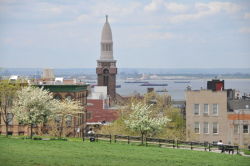
Sunset Park, located between 41st and 44th Street and 5th and 7th Avenue, was once rural farmland owned by John G. Bergen.
The City of Brooklyn acquired the land in 1891, when councilmen
recognized that rapid transit would bring large-scale development to the
area. The park preserves some of the beauty that the neighborhood lost
when development accelerated in the late 19th century.

This
aerial view shows the massive Brooklyn Army Terminal and pier. The Kerr
Steamship pier, which would have been to the right of the BAT pier, is
only a distant memory today.
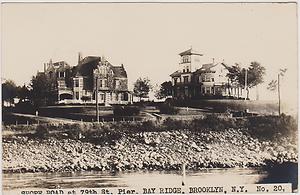
Numerous mansions lined the Bay Ridge waterfront in the 1800s,
including those of Henry A. Kent, Henry C. Murphy, J.A. Perry, Horace
Holden, R. Van Brunt, and William C. Langley. After 1940, most of Shore
Road’s mansions, like the Bennett estates shown here, were torn down and
replaced by high-rise apartment buildings.